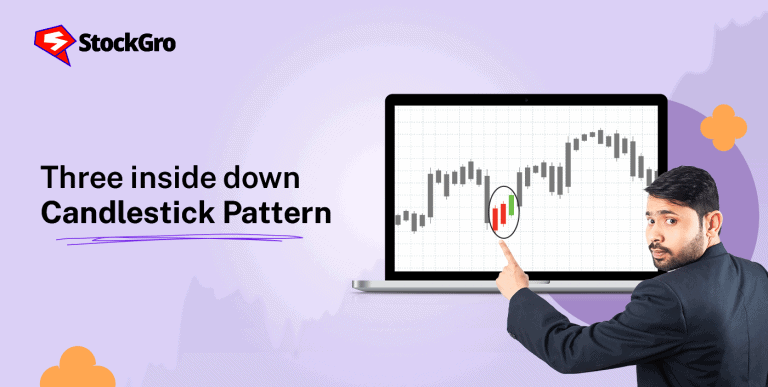
Uncertainty is a common theme in trading, especially when the usual signals don’t say much. That’s where the double doji pattern comes in. Formed when two indecisive candles appear in a row, it reflects a market waiting for direction. Looking forward to knowing what it could mean for trend shifts or momentum breaks? This blog will discuss its meaning, setup, and more!
What is a Double Doji Pattern?
A double doji pattern is made up of two doji candlesticks patterns appearing one after the other. A single doji shows market hesitation, with neither buyers nor sellers in control. When two appear back-to-back, it highlights even more uncertainty. The first doji signals hesitation, and the second one confirms that the market is unsure of its direction.
How is a Double Doji Formed?
A doji forms when a security opens and closes at nearly the same price. During the session, the price moves both up and down, but eventually returns close to where it started. This back-and-forth between buyers and sellers results in a small or non-existent candle body, shaped like a cross or plus sign. Doji candles come in three colours:
- A green doji shows a close slightly above the open.
- A red doji closes slightly beneath its opening price.
- A black doji opens and ends at the exact price level.
These setups may emerge during pauses and hint at continuation or reversal.
What Does the Double Doji Pattern Indicate?
The double doji pattern on a candlestick chart shows a phase of continued hesitation. Since a single doji already hints at a tug-of-war between buyers and sellers, two in a row amplify that uncertainty. This usually happens before the market chooses a direction. The narrow price movement during these candles shows neither side has enough strength to take control, making it a sign to observe what follows closely.
For example, in the Glenmark Pharmaceuticals Limited chart below, the two dojis marked in black boxes appear on different days. One in mid-July and another around July 24–25 form a double doji pattern, hinting strong indecision across two separate sessions.

Double vs Single Doji
A single doji shows a pause in market activity during one session, while a double doji reflects a prolonged standstill across two sessions. When two dojis appear together, it signals a stronger lack of direction in price movement. This extended period of balance between buyers and sellers often draws closer attention, as it may be followed by a clearer price move than what typically follows a single doji.
Types of Doji Patterns
The main types of doji patterns are as follows:
- Standard doji
Standard doji resembles a plus or cross sign, with similar-sized upper and lower shadows.It occurs when opening and closing rates remain nearly the same. On its own, it doesn’t signal much but gains meaning when seen alongside other candles. Its interpretation depends on what comes before and after it.
- Long-legged doji
Long legged doji extended upper and lower shadows with a minimal or missing core body. This pattern shows that the price moved significantly in both directions during the session, but closed near its opening value. It signals a strong tug-of-war between buyers and sellers without either side gaining control.
- Dragonfly doji
The dragonfly doji displays a stretched lower tail, with the open, high, and close clustered at the top.It forms when sellers drive the price down early, but buyers bring it back up by the close. This shape suggests strong buying interest and often appears near the lower end of price moves.
- Gravestone doji
The gravestone doji pattern has a long upper wick, with open, low, and close grouped near the bottom. It forms when buyers push prices higher after the open, but sellers regain control by the close. Often seen after an upward move, it hints at fading buying strength late in the session.
How to Trade Using the Double Doji Pattern
Here are the three core steps to follow when trading with doji candlestick patterns:
- Identify a doji where opening and ending values match, leaving a narrow or flat body. The length of the upper and lower shadows varies by type, but the key is spotting the small body that stands out on the chart.
- Use a supporting indicator like RSI or stochastic to validate the pattern. For instance, if a doji appears during a down move and RSI shows an oversold level, it may support a bullish signal.
- Figure out strategy based on what the combined signals suggest. Some choose to enter a position in the direction of the expected move and place stop-loss orders to manage risk if the price moves the other way.
Double Doji Trading Strategies
Below are a few ways to combine the double doji with other tools for better technical analysis:
- Double doji with moving averages
Moving averages help smooth price fluctuations across a set period, to point to the overall trend direction. When a double doji forms near a key moving average (like the 50-day or the 200-day), it can highlight recultancy near important levels, making it useful for watching a possible move.
- Double doji with RSI or stochastic
The RSI and stochastic are momentum indicators that show whether a stock is overbought or oversold. RSI values below 30 or Stochastic below 20 suggest oversold conditions, while values above 70 or 80 show overbought conditions. A double doji forming alongside these readings adds weight to the signal.
- Double Doji with support & resistance
Support and resistance are horizontal levels where price has previously reversed or stalled, often due to increased buying or selling interest. When a double doji forms near these, it indicates that price is once again reacting to that level, strengthening the case for a possible directional move or continuation.
Advantages of the Double Doji Pattern
The key benefits of using the double doji pattern are listed below:
- Helps spot possible reversal points early in price action.
- Recognizable by its slim body and balanced cross-style form.
- Can improve timing when combined with indicators or moving averages.
- Works across short- and long-duration charts.
- Useful in different markets like stocks, p, and forex.
- Helps traders assess pause zones before price moves again.
- Can complement patterns like support/resistance or engulfing candles.
- Offers visual confirmation of slowing momentum in price.
- Helps filter noise in volatile markets when backed by other tools.
- Performs well in upward as well as downward price environments.
Limitations of the Double Doji Pattern
Despite its various benefits, the double doji pattern also has some drawbacks:
- Does not always signal a clear direction on its own.
- May be misread if the doji type is not correctly identified.
- Needs confirmation from later candles, which delays decision-making.
- Can give misleading signals during high market volatility.
- Appears rarely, making it harder to use frequently.
- Less effective on lower timeframes like 5-min or 15-min charts.
- Often confused with similar narrow-bodied candles.
- May reflect sideways movement instead of a clear reversal.
- Risk of losses if used without supporting indicators.
- Requires some practice to read in different market contexts.
How Reliable is the Double Doji Pattern?
The double doji pattern is generally more reliable when paired with other technical indicators. On its own, it does not give enough information, especially because it appears rarely and may not always indicate a directional change. It often marks a pause in price action, so confirmation with follow-up patterns or tools like RSI or moving averages is usually preferred for better clarity.
Double Doji Pattern vs Other Candlestick Patterns
Different candlestick patterns vary in their structure and the kind of price action they reflect. Here’s how the double doji compares to a few commonly used patterns:
Double Doji vs Harami
These two patterns differ in how they reflect market pauses and the way candle bodies are formed.
| Feature | Double doji | Harami |
| Number of candles | Two | Two |
| Composition | Two consecutive doji candles with nearly equal open and close prices. | A large candle followed by a smaller one entirely within the body of the first. |
| Body size | Almost no real body in both candles. | The first candle has a full body; the second is narrow. |
| Market signal | Reflects strong indecision and lack of clear direction. | Indicates a slowdown in the strength of the current trend. |
| Common use | Seen as a pause before a possible move in either direction. | Often used to watch for weakening price direction. |
Double Doji vs Morning Star
These patterns differ in both their structure and how clearly they point to a change after a price drop.
| Feature | Double doji | Morning star |
| Number of candles | Two | Three |
| Composition | Two back-to-back doji candles. | A bearish candle, a small-bodied candle, then a bullish candle. |
| Body size | Both candles have very small or no real bodies. | Mixture of small and large bodies showing a transition in strength. |
| Market signal | Neutral; requires confirmation for direction. | Clear bullish reversal pattern after a decline. |
| Common use | Indicates a standstill in price movement. | Watched for signs of upward movement after a downtrend. |
Double Doji vs Evening Star
While both can occur near market tops, the evening star offers a clearer and more directional signal.
| Feature | Double doji | Evening star |
| Number of candles | Two | Three |
| Composition | Two consecutive doji candles. | A bullish candle, followed by a small-bodied candle, then a bearish candle. |
| Body size | Both candles are narrow with little or no body. | Combines full and small bodies to form a reversal shape. |
| Market signal | Neutral, showing a balance between buying and selling. | Bearish reversal pattern appearing after an upward price move. |
| Common use | Highlights pause zones or potential turning points. | Used to spot a price reversal at the end of an uptrend. |
Conclusion
The double doji pattern stands apart not just for its scarcity but for what it reveals, a clear pause in price action. While it doesn’t signal direction by itself, its appearance often marks a moment worth watching closely. When combined with additional tools or chart patterns, it can help decode what the market might be preparing for next.
FAQs
A double doji pattern consists of two consecutive doji candles with nearly equal open and close prices. It signals strong market indecision and often precedes a significant price move or breakout in either direction.
There is no direct opposite of the double doji since it represents indecision. Patterns like Marubozu, which show strong buyer or seller conviction with large bodies, can be considered opposites reflecting clear momentum instead of uncertainty.
The double doji pattern is neutral. It shows balanced indecision between buyers and sellers and does not predict direction. The next price move, either up or down, depends on the breakout after the pattern forms.
Yes, the double doji can form on any timeframe, minutes, daily, weekly, or monthly charts. Its signals are generally clearer and more reliable on higher timeframes due to less random price fluctuation.
The double doji is a stronger indecision signal than a single doji and often precedes big moves, but its accuracy improves with confirmation from volume or other indicators. Alone, it signals a likely move but not the direction or size.

